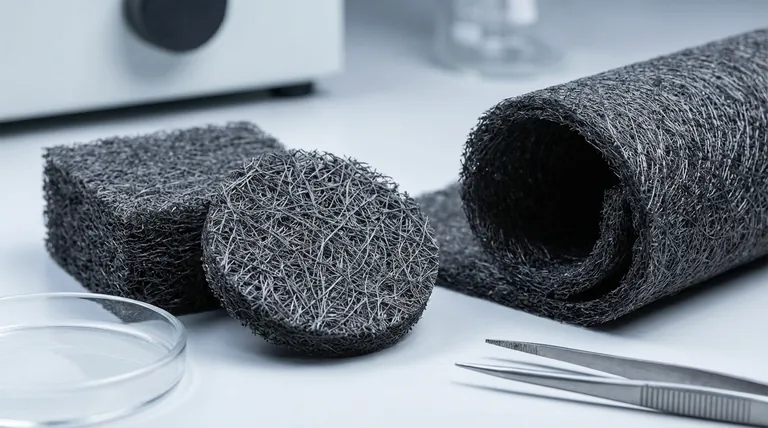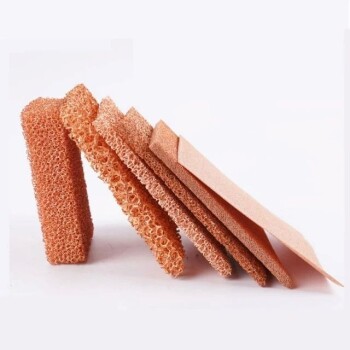At its core, carbon felt is a non-woven mat composed of countless individual carbon fibers that are tangled together in a random, irregular pattern. This seemingly simple arrangement creates a highly porous, three-dimensional network that gives the material its unique and valuable set of properties.
The key to understanding carbon felt is recognizing that its jumbled, non-woven structure is not a flaw but its greatest asset, creating a vast internal surface area and low density that define its performance in thermal and electrical applications.

Deconstructing the "Felt-Like" Structure
To truly grasp how carbon felt works, we must look closer at its fundamental composition. It is more than just a simple sheet; it is a complex internal architecture.
The Foundation: Carbon Fibers
The building blocks of the material are short, strong, and lightweight carbon fibers. These individual strands are the basis for the entire structure.
An Irregular and Interwoven Arrangement
Unlike a woven fabric like carbon cloth, which has a neat, grid-like pattern, the fibers in carbon felt are interlocked randomly. This non-woven arrangement is what creates significant empty space, or voids, throughout the material.
A Three-Dimensional Network
The fibers are not arranged in a flat plane. They crisscross and overlap in all directions, forming a deep, three-dimensional porous structure. This creates a material that is mostly open space by volume, making it exceptionally lightweight.
How Structure Dictates Function
The physical arrangement of the fibers directly translates to the material's most important functional properties. The "why" behind its usefulness is found in its architecture.
High Porosity and Low Density
The vast network of voids created by the tangled fibers makes carbon felt highly porous. This structure is excellent at trapping gases, which is why it is a superior high-temperature insulator. This porosity also results in a very low overall density.
Massive Specific Surface Area
Because countless individual fibers are exposed within the 3D network, the material has an incredibly high specific surface area. This is critical for electrochemical applications, such as in flow battery electrodes, where it provides ample sites for chemical reactions to occur.
Pathways for Conductivity
Although the fibers are arranged randomly, they are in constant contact with one another. This web of connections creates continuous pathways for electricity and heat to travel, giving the material its stable thermal and electrical conductivity.
Understanding the Trade-offs
The unique structure of carbon felt also introduces inherent limitations that are critical to understand for proper application.
Mechanical Strength Limitations
The non-woven, porous nature of carbon felt means it lacks the tensile strength of woven fabrics or the compressive strength of solid graphite. It can be easily torn, pulled apart, or compressed under load, making it unsuitable for structural or load-bearing roles.
Potential for Fiber Shedding
The ends of the interwoven fibers can be loose on the surface of the felt. This can lead to minor shedding of carbon fibers, which may be a concern in applications requiring extreme cleanliness or where particulates could interfere with a system.
Matching Structure to Application
Your specific goal will determine which aspect of carbon felt's structure is most important.
- If your primary focus is high-temperature insulation: The key feature is the three-dimensional porous network, which traps gas and minimizes heat transfer.
- If your primary focus is electrochemical performance: The massive specific surface area and electrical conductivity are the most critical properties for enabling efficient reactions.
- If your primary focus is a structural component: Carbon felt is generally the wrong choice due to its low mechanical strength; a woven carbon fabric or composite would be a better alternative.
By understanding its tangled, porous network, you can effectively leverage the unique capabilities of carbon felt for your specific project.
Summary Table:
| Structural Feature | Functional Property | Key Application |
|---|---|---|
| Random, non-woven fiber arrangement | High porosity & low density | High-temperature insulation |
| Three-dimensional fiber network | Massive specific surface area | Electrochemical electrodes (e.g., flow batteries) |
| Interconnected fiber web | Thermal & electrical conductivity | Heating elements, current collectors |
| Low mechanical strength | Not suitable for load-bearing | Avoid in structural applications |
Ready to leverage the unique properties of carbon felt in your lab?
At KINTEK, we specialize in providing high-quality lab equipment and consumables, including premium carbon felt tailored for demanding thermal and electrochemical applications. Our materials offer the high surface area, excellent porosity, and reliable conductivity your research requires.
Let our experts help you select the right material for your project. Contact us today to discuss your specific needs and discover how KINTEK can enhance your laboratory's capabilities!
Visual Guide

Related Products
- Copper Foam
- Glassy Carbon Sheet RVC for Electrochemical Experiments
- Molybdenum Disilicide (MoSi2) Thermal Elements Electric Furnace Heating Element
- Silicon Carbide SiC Thermal Heating Elements for Electric Furnace
- Custom PTFE Teflon Parts Manufacturer for PTFE Mesh F4 Sieve
People Also Ask
- Is copper foam safe? Discover the facts about its antimicrobial and cooling benefits
- What electrostatic protection measures should be taken when using nickel and copper foam? Essential ESD Safety Protocols
- What is copper foam used for? A Guide to Its High-Performance Thermal and Energy Applications
- How can different materials have different heat capacity? Unlocking the Microscopic Secrets of Energy Storage
- What are the common applications of copper foam? A Guide to Its High-Performance Uses













